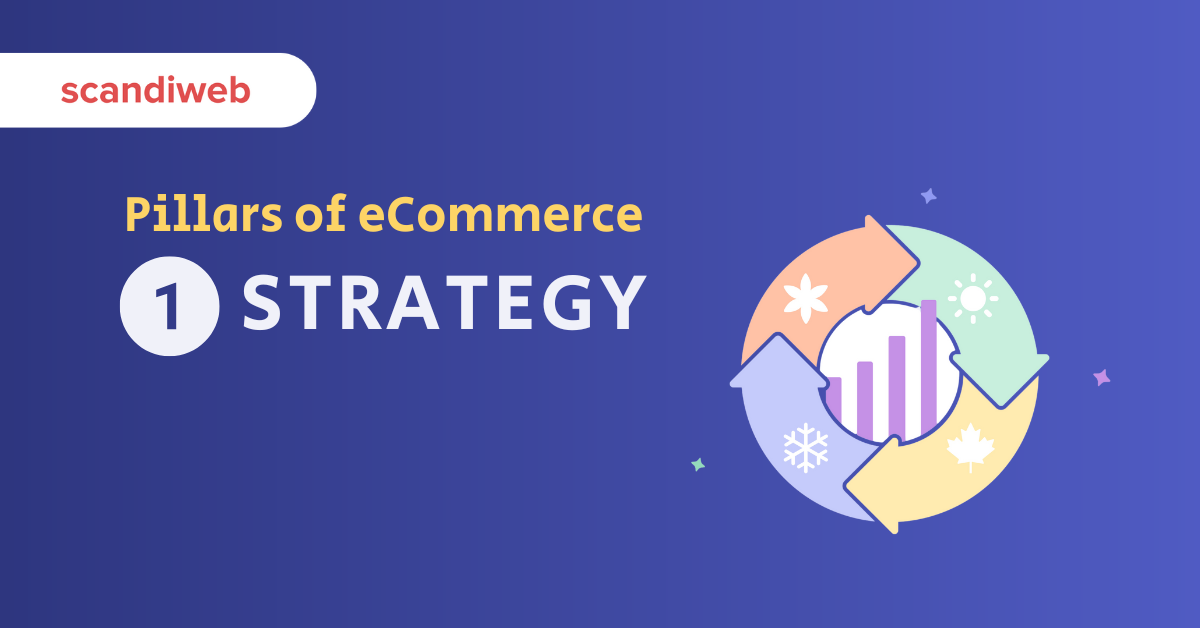Strategy is a foundational pillar in the architecture of successful eCommerce operations, guiding businesses through the complexities of the digital marketplace. It includes creating a strategic roadmap that aligns your business objectives with market needs and operational capabilities. This holistic approach ensures that every facet of your eCommerce business—from technology integration to customer engagement—is strategically optimized for growth and sustainability.
This article is the first in a series exploring the 5 pillars of eCommerce, providing insights into each pillar’s impact and importance.
Strategic eCommerce roadmap
A strategic eCommerce roadmap is a comprehensive plan that acts as a guide, outlining necessary steps and strategies to achieve targeted growth and market penetration. It considers various aspects of your business, from digital marketing to supply chain logistics, ensuring that all elements work cohesively toward your shared goals. This roadmap offers a comprehensive framework for aligning your operations with your strategic vision and long-term goals.
Implementing your strategic eCommerce roadmap involves a detailed analysis and integration of market research, competitor analysis, and consumer behavior trends. This approach allows you to identify unique opportunities and challenges within your market and tailor your strategies accordingly. The roadmap sets a clear path for scaling your operations and helps prioritize initiatives that maximize investment returns. By following this comprehensive plan, you can streamline your processes, enhance customer experiences, and ensure that your business remains competitive.
After identifying market opportunities and establishing business objectives, you should focus on three primary drivers that bring these goals to life.
Digital ecosystem
Think of your digital ecosystem as the operational hub of your business. This is where all your data is processed, systems are interconnected, products are displayed, and customer orders are handled. Like a well-run restaurant, your digital setup should seamlessly integrate the finest ingredients—from data flow to system integration—ensuring everything operates smoothly behind the scenes. However, having a polished backend system is just the starting point. Attracting visitors to experience and interact with your digital environment is the crucial next step.
Customer lifecycle
The customer lifecycle is your strategy for filling this digital ecosystem with continuous traffic and converting that traffic into orders. This process involves acquiring traffic, enhancing customer conversion rates, re-engaging past customers, and building customer loyalty. You might use a variety of tactics, from performance marketing to AI-driven personalization and from conducting A/B tests on abandoned cart emails to deploying targeted retargeting campaigns. The goal is to fill your ecosystem with customers and ensure they are engaged and satisfied with their experience.
Customer experience
Customer experience is the visible layer of your strategy, impacting how customers perceive and interact with your brand throughout their entire journey—from the moment they become aware of your brand through their first purchase to the point where they become loyal promoters. You can start sculpting the customer experience by setting clear business objectives and selecting tools that enhance the envisioned customer journey. Alternatively, you may first strengthen and optimize your digital ecosystem, attract the right kind of traffic, evaluate the ongoing customer experience, and refine your strategies to improve and maintain it continually.
These strategic elements collectively ensure that your eCommerce operations are efficient and effective in engaging and retaining customers, thereby driving growth and sustainability in a competitive marketplace.
Ecosystem discovery and planning
Ecosystem discovery and planning play an essential role in optimizing your operations. This phase involves a thorough assessment of your current digital ecosystem, identifying areas that require enhancement or total transformation. By understanding the digital core of your business—where data flows, systems are integrated, and customer interactions occur—you can create a more efficient and responsive infrastructure.
Effective ecosystem planning allows you to integrate new technologies and streamline existing processes. It’s akin to orchestrating a complex system where each component—from product visibility to order placement and data analytics—works seamlessly together. This improves operational efficiency and enhances the customer experience, ensuring that they find value in every interaction with your business. With a well-planned ecosystem, you’re better equipped to manage and analyze customer behavior and operational data, which is crucial for making informed business decisions and driving growth.
3 benefits of the discovery process
1. Lower project cost
The discovery process offers a complete view of the systems, their requirements, components, and modules, which reduces uncertainties and potential risks associated with unclear project scopes. As a result, project estimates can be significantly more accurate, often reducing initial cost projections by up to 30%.
2. Better project quality
It provides a holistic view of the project and a detailed focus on individual components and features, enabling precise quality management and alignment with business-level acceptance criteria set by key stakeholders.
3. Improved timeline planning
Effective discovery processes aid in better timeline management by preemptively addressing potential delays through detailed and scheduled planning. It ensures that all necessary stakeholders, from department leads to third parties, are aligned and understand their deliverables, contributing to smoother project evolution and adherence to set timelines.
Wrapping Up
As we conclude our exploration of the Strategy pillar, it’s clear that a robust strategy is not merely beneficial but essential for thriving in the competitive eCommerce sector. From laying out a strategic eCommerce roadmap that aligns with your long-term goals to diving deep into ecosystem discovery and planning, each component is critical in enhancing your operational efficiency and market positioning.
By systematically applying these strategies, you ensure that your business meets current market demands and is prepared for future challenges and opportunities.
Ultimately, the strategic integration of digital ecosystems, customer lifecycle management, and superior customer experience underpins your ability to attract, satisfy, and retain customers, driving sustainable growth and success.
If you haven’t already, explore our article on the 5 Pillars of eCommerce, which sets the foundation for success in the digital marketplace.
Explore our popular eCommerce services
Don’t get lost in the eCommerce maze. scandiweb can help you craft a winning online strategy. Contact us today by filling out the form below.
Quickly jump to the other pillars of eCommerce here


Share on: